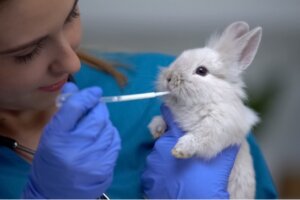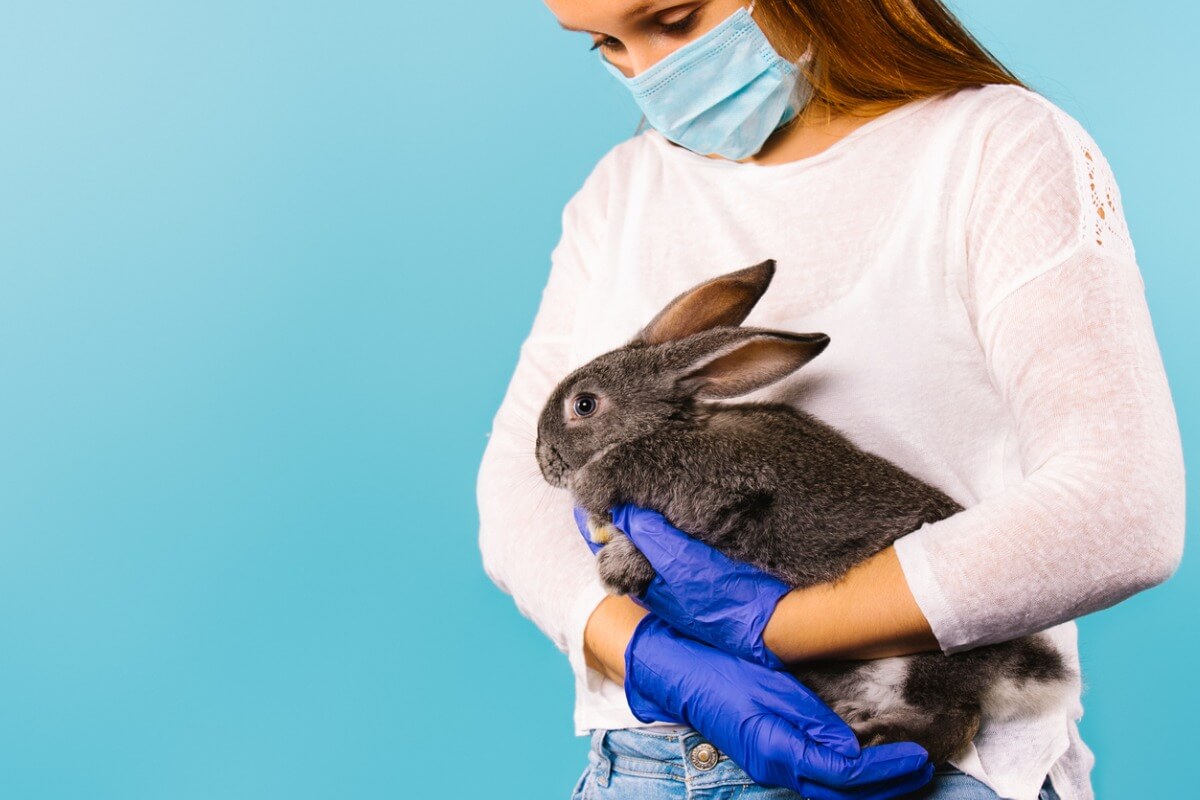12 Signs that a Rabbit Is Sick


Written and verified by the biologist Samuel Sanchez
Animals that are prey for others in the natural environment are often adept at camouflaging their vulnerability. This mechanism is a clear necessity. As predators always select the weakest specimens, appearing fragile can mean death. For this reason, detecting the symptoms that a rabbit is sick is very difficult.
Rabbits and hares are the natural diet for many large mammals (such as foxes, wolves and lynxes), it’s instinctive for them to never show themselves to be dying. Even if they’re in captivity, this behavior is maintained by genetic inheritance. Keep reading if you want to know 12 signs that your rabbit is sick.
1. Food changes
Rabbits are prone to suffer from intestinal stasis, a clinical condition characterized by a decrease or the stopping of the normal muscle movements in the digestive system. This causes them to stop eating as they feel constantly full and bloated.
On the other hand, a rabbit may stop eating if its incisor teeth are too long. The lack of filing of a rabbit’s teeth causes them a lot of oral pain (accompanied by wounds and bleeding).
2. Changes in the faeces (or absence of faeces)
Intestinal stasis in rabbits is also manifested by the absence of faeces. On the other hand, many infectious diseases cause diarrhoea in these mammals and it’s easy to detect if you monitor the faeces they produce every day. When you clean the cage, keep an eye on the stools and check that their consistency and number are adequate.
The generalities of rabbit stools can be summarized in the following points:
- Normal: Brown, regular, and circular in shape.
- Abnormal: Clumped, yellowish, mucus-covered, foul-smelling, and non-standard in shape.
3. Changes in energy levels
Every rabbit should leave its cage for at least 2 hours a day to exercise. When they’re released, these lagomorphs tend to be enthusiastic and will jump around as much as they can. If the rabbit stays in one spot when you let the animal loose, then this is one of the clearest symptoms that your rabbit is ill.
4. Foot rot
The term “foot rot” refers to a clinical condition known as plantar necrosis. This pathology affects lagomorphs which are in unsuitable cages and manifests itself with swelling, purulence, and pain in the back legs. All the medical signs which show this condition require immediate veterinary attention.

5. Changes in posture
One of the most evident symptoms that a rabbit is sick is the abnormal change in posture. If they’re not well, these animals tend to avoid touching the ground with their stomach (especially if they have excess gas or constipation). They may be restless as they’re not able to adopt the right position for resting.
6. Hair loss
Unlike other animals, hair loss in rabbits (apart from their seasonal molting) is always considered a problem. If you see that your rabbit has bare patches of skin, it’s most likely that it’s carrying external parasites. In these cases, veterinary attention and topical medications are required.
7. Changes in respiratory rate
Rabbits are obligate nasal breathers, so any changes in the upper respiratory tract will be more problematic for them than for a dog, for example. The normal respiratory rate for an adult rabbit is 30 to 60 breaths per minute. If you see that your pet is constantly hyperventilating, it may be stressed or have an infection.
As professional sources indicate, it’s also a sign of a problem if each respiratory cycle is accompanied by abnormal sounds. In addition, the animal usually sits down and keeps its head slightly tilted upwards when it’s not breathing well.
8. Drooling
Rabbits produce saliva normally, but it’s not at all common for it to escape from the corners of its lips and wet its fur. This condition is known as ptyalism and indicates a maladjustment in the mouth area. It’s is one of the clearest signs that a rabbit is ill, specifically concerning pathologies such as gingivitis, tetanus, and various metabolic disorders.
An excessive growth of the teeth also causes drooling in rabbits.
9. Head cocked to one side
The head cocked to one side can seem normal in a rabbit but it almost always indicates a pathology if it’s maintained over time. The infection of one of the ears is the most common cause of this symptom, but protozoan infestations, cerebral cancers and cerebrovascular accidents can also cause it.
With the appropriate treatment, this symptom of illness in the rabbit can be solved (especially if the cause is an infectious agent). In any case, its manifestation is always evidence of a medical emergency.
10. Obesity
Obesity isn’t only a symptom of pathology in these mammals, but is also a disease in itself. Excess weight in these animals isn’t very easy to identify, as they have a thick layer of fur that prevents you from checking on its physical constitution. Therefore, if you think your rabbit is obese, then the best option is to weigh it.
A rabbit weighs on average 2 to 4 kilos (4.4 – 8.8 pounds), although some varieties are larger. Your rabbit is probably overweight if it deviates too much from this standard upwards.
11. Teeth grinding
Animals tend to naturally grind their teeth a little, but it isn’t normal for this behaviour to be constant or very noisy. Any guardian will know how to identify this clinical sign if they have been with their rabbit long enough. If the grinding of the teeth can be heard constantly from far away then the animal is probably experiencing acute pain.
12. Ears which are very hot or very cold
Rabbits use their ears to thermoregulate. These structures have a large surface area and are very thin, so they’re perfect for the animal to dissipate heat in environments with high temperatures. However, it isn’t normal for them to be excessively hot to the touch, as this indicates that the animal’s temperature is abnormal.
Neither is it good for the rabbit’s ears to be very cold as this is evidence of a lack of blood flow to the area.

As you can see many symptoms can indicate that a rabbit is sick. If you detect any of these clinical signs for more than a few hours in your animal, then go to the vet as soon as possible. When it comes to pet health, it’s always better to be on the safe side.
Animals that are prey for others in the natural environment are often adept at camouflaging their vulnerability. This mechanism is a clear necessity. As predators always select the weakest specimens, appearing fragile can mean death. For this reason, detecting the symptoms that a rabbit is sick is very difficult.
Rabbits and hares are the natural diet for many large mammals (such as foxes, wolves and lynxes), it’s instinctive for them to never show themselves to be dying. Even if they’re in captivity, this behavior is maintained by genetic inheritance. Keep reading if you want to know 12 signs that your rabbit is sick.
1. Food changes
Rabbits are prone to suffer from intestinal stasis, a clinical condition characterized by a decrease or the stopping of the normal muscle movements in the digestive system. This causes them to stop eating as they feel constantly full and bloated.
On the other hand, a rabbit may stop eating if its incisor teeth are too long. The lack of filing of a rabbit’s teeth causes them a lot of oral pain (accompanied by wounds and bleeding).
2. Changes in the faeces (or absence of faeces)
Intestinal stasis in rabbits is also manifested by the absence of faeces. On the other hand, many infectious diseases cause diarrhoea in these mammals and it’s easy to detect if you monitor the faeces they produce every day. When you clean the cage, keep an eye on the stools and check that their consistency and number are adequate.
The generalities of rabbit stools can be summarized in the following points:
- Normal: Brown, regular, and circular in shape.
- Abnormal: Clumped, yellowish, mucus-covered, foul-smelling, and non-standard in shape.
3. Changes in energy levels
Every rabbit should leave its cage for at least 2 hours a day to exercise. When they’re released, these lagomorphs tend to be enthusiastic and will jump around as much as they can. If the rabbit stays in one spot when you let the animal loose, then this is one of the clearest symptoms that your rabbit is ill.
4. Foot rot
The term “foot rot” refers to a clinical condition known as plantar necrosis. This pathology affects lagomorphs which are in unsuitable cages and manifests itself with swelling, purulence, and pain in the back legs. All the medical signs which show this condition require immediate veterinary attention.

5. Changes in posture
One of the most evident symptoms that a rabbit is sick is the abnormal change in posture. If they’re not well, these animals tend to avoid touching the ground with their stomach (especially if they have excess gas or constipation). They may be restless as they’re not able to adopt the right position for resting.
6. Hair loss
Unlike other animals, hair loss in rabbits (apart from their seasonal molting) is always considered a problem. If you see that your rabbit has bare patches of skin, it’s most likely that it’s carrying external parasites. In these cases, veterinary attention and topical medications are required.
7. Changes in respiratory rate
Rabbits are obligate nasal breathers, so any changes in the upper respiratory tract will be more problematic for them than for a dog, for example. The normal respiratory rate for an adult rabbit is 30 to 60 breaths per minute. If you see that your pet is constantly hyperventilating, it may be stressed or have an infection.
As professional sources indicate, it’s also a sign of a problem if each respiratory cycle is accompanied by abnormal sounds. In addition, the animal usually sits down and keeps its head slightly tilted upwards when it’s not breathing well.
8. Drooling
Rabbits produce saliva normally, but it’s not at all common for it to escape from the corners of its lips and wet its fur. This condition is known as ptyalism and indicates a maladjustment in the mouth area. It’s is one of the clearest signs that a rabbit is ill, specifically concerning pathologies such as gingivitis, tetanus, and various metabolic disorders.
An excessive growth of the teeth also causes drooling in rabbits.
9. Head cocked to one side
The head cocked to one side can seem normal in a rabbit but it almost always indicates a pathology if it’s maintained over time. The infection of one of the ears is the most common cause of this symptom, but protozoan infestations, cerebral cancers and cerebrovascular accidents can also cause it.
With the appropriate treatment, this symptom of illness in the rabbit can be solved (especially if the cause is an infectious agent). In any case, its manifestation is always evidence of a medical emergency.
10. Obesity
Obesity isn’t only a symptom of pathology in these mammals, but is also a disease in itself. Excess weight in these animals isn’t very easy to identify, as they have a thick layer of fur that prevents you from checking on its physical constitution. Therefore, if you think your rabbit is obese, then the best option is to weigh it.
A rabbit weighs on average 2 to 4 kilos (4.4 – 8.8 pounds), although some varieties are larger. Your rabbit is probably overweight if it deviates too much from this standard upwards.
11. Teeth grinding
Animals tend to naturally grind their teeth a little, but it isn’t normal for this behaviour to be constant or very noisy. Any guardian will know how to identify this clinical sign if they have been with their rabbit long enough. If the grinding of the teeth can be heard constantly from far away then the animal is probably experiencing acute pain.
12. Ears which are very hot or very cold
Rabbits use their ears to thermoregulate. These structures have a large surface area and are very thin, so they’re perfect for the animal to dissipate heat in environments with high temperatures. However, it isn’t normal for them to be excessively hot to the touch, as this indicates that the animal’s temperature is abnormal.
Neither is it good for the rabbit’s ears to be very cold as this is evidence of a lack of blood flow to the area.

As you can see many symptoms can indicate that a rabbit is sick. If you detect any of these clinical signs for more than a few hours in your animal, then go to the vet as soon as possible. When it comes to pet health, it’s always better to be on the safe side.
All cited sources were thoroughly reviewed by our team to ensure their quality, reliability, currency, and validity. The bibliography of this article was considered reliable and of academic or scientific accuracy.
- 17 ways to know your rabbit is sick, The bunny Lady. Recogido a 27 de septiembre en https://bunnylady.com/is-your-rabbit-sick/
- Mal de patas en conejos, Agromeat. Recogido a 27 de septiembre en https://www.agromeat.com/76442/mal-de-patas-en-conejos
- Rabbit Emergencies, The rabbit heaven. Recogido a 27 de septiembre en https://therabbithaven.org/rabbit-emergencies
This text is provided for informational purposes only and does not replace consultation with a professional. If in doubt, consult your specialist.








